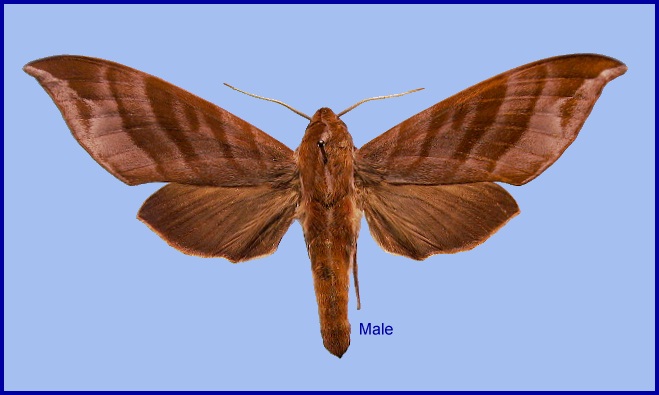
Ampelophaga khasiana Rothschild, 1895, Novit. zool. 2: 482. Type locality: [India], Assam [Meghalaya], Khasia Hills [Khasi Hills].
Wingspan: 80--102mm. Upperside deeper in colour than in Ampelophaga rubiginosa, the mesial line less pale. Antennae with dark scaling at tip. Palpus first segment not greyish white. Sides and underside of body much more red than in Ampelophaga rubiginosa. Forewing uppersides with the spaces between the various bands glossy whitish-grey; discal band somewhat narrower and more sharply defined than in Ampelophaga rubiginosa, the discal line broad, band-like, not dentate. In fresh specimens the forewings have a beautiful violet sheen when viewed at certain angles.
In the male genitalia, uncus not sinuate in distal view. Harpe with dilated apical part longer than in Ampelophaga rubiginosa, more heavily spined proximally. Phallus with right process of longer than in Ampelophaga rubiginosa.
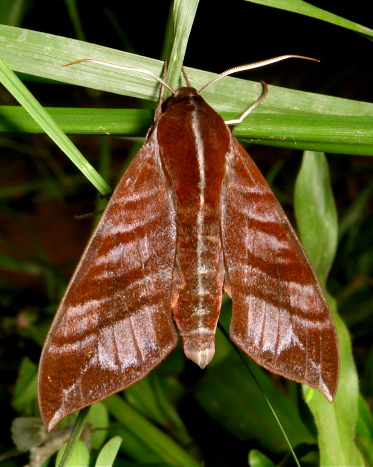
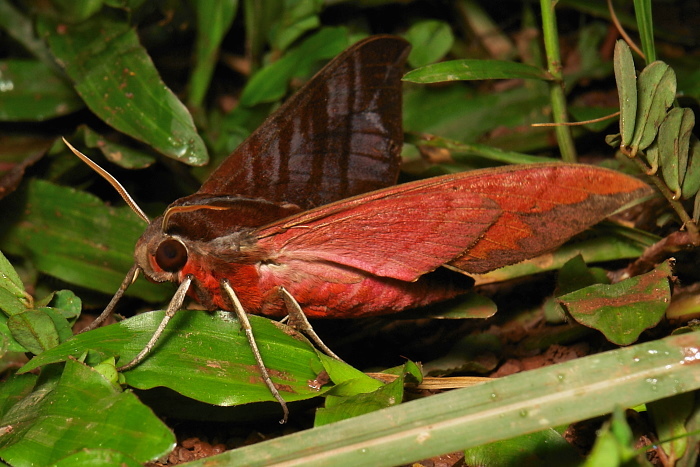
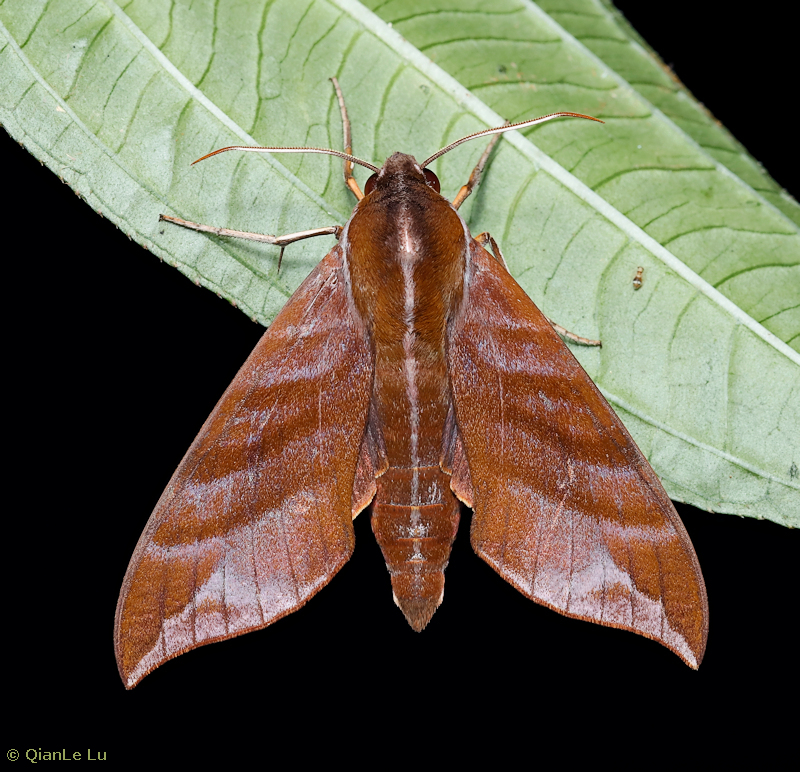
China: v (Yunnan); vi (Sichuan; Yunnan); 8-30.vii (Yunnan); viii (Guangxi); ix (Xunyang, Shaanxi); 3.x (Yunnan).
OVUM:
LARVA: Full-fed 85 mm, breadth 12 mm. According to Bell & Scott (1937), in the final instar head rather square in shape, vertex rounded, true clypeus nearly half length of head, apex minutely rounded, false clypeus shaped like a gothic arch over apex of true clypeus. Labrum one-half the length of and slightly broader than clypeus; ligula nearly square, as long and as broad as clypeus. Eyes 1-4 equidistant in a gentle curve, 6 in line with 3 and 4, 5 forming an equilateral triangle with 4 and 6. Surface of head moderately shiny and set sparsely with small, glassy, bubble-like tubercles. Body as in others of the genus. Horn down-curved, stout at base, tapering gently to a conical tip. Surface of body dull, with a transverse row of rounded tubercles along each secondary ring. There is also a dorso-lateral line of tubercles from the front margin of segment 2 to base of horn; these tubercles rounded, except for those on the three or four anterior secondary rings of segments 6-12, which are conical, almost spine-like, the tubercle on the second or on the third ring being longer and more spiniform than the rest. A line of large rounded tubercles starts at the dorsal line at the front margins of 6 to 11, and run obliquely backwards and downwards to near the dorso-lateral line of tubercles, forming V-shaped markings, the apex of the V directed frontad. Horn set with small conical tubercles up to the tip; anal flap and clasper faces set with small truncate conical tubercles.
In colour, head dark green, the tubercles paler green, with a broad yellow stripe separating the face from cheek. There is a broad paler green facial stripe, widening frontad to include the clypeus. Labrum and ligula yellowish-green; mandible green, tip broadly black; antenna with basal segment green, other segments rust-coloured. Body bright bluish-green dorsally, but bright green laterally; tubercles yellow. There are seven indistinct pale oblique lateral stripes. Horn green with paler tubercles; legs pink, with a large deep brown patch on outer side of each, and a bright yellow patch on venter of body near the base of each leg. Spiracles whitish, with a broad reddish-brown band across the middle divided by the whitish central slit.
PUPA: 47mm long, 15mm wide. Very similar in appearance to that of Acosmeryx r. rubiginosa. Colour pale ochreous with a pinkish shade. Dorsum of abdomen strongly suffused with reddish-brown, segments 12-14 darker than the rest. Bevels of the mobile segments chestnut; spiracles, cremaster and the gashes on segments 4, 5 and 6, and the undercut of portion 11, black. Stout in build, head round, the anal end resembling an Acosmeryx pupae in that segments 12-14 are fused together to form a cone, the hind margin of 11 being of greater diameter than the front margin of 12 and deeply undercut, especially in the dorsal area. Surface smooth, moderately shiny dorsally and dull ventrally; a deep transverse gash on dorsum at the common margin of segments 4 and 5, and a less conspicuous gash at the common margin of 5 and 6. Spiracle of 2 a curved slit, the remaining spiracles oval, flush, the slit with narrow raised edges. Cremaster a thin shaft, tapering gently to the truncate tip, the surface irregularly wrinkled to near the tip (Bell & Scott, 1937).
Larval hostplants. Vitis and Saurauia nepalensis in India (Bell & Scott, 1937).
China: Shaanxi (Xunyang, 1380m); Sichuan (Baoxing; Kangding); Yunnan (Changning County, Songzhishanding, 2800m; nr. Yingjiang, 2080m; Tengchong, 1800-2240m; Mengla County, Mt. Leigongyan, 2000m; Gaoligong Shan; Simao/Pu'er; Dawei Shan; Kunming); eastern Xizang/Tibet (Baxoi County); Hunan (Xiaozhuangping, Sangzhi, Zhangjiajie); Guangxi (Huaping National Nature Reserve).
?Nepal, northestern India (Sikkim, Arunachal Pradesh, Nagaland), Bhutan (Irungbam & Irungbam, 2019), northern Myanmar (Banmauk, Sagaing Province) to central-southern China, Laos and central Vietnam (Le & Vu, 2024).
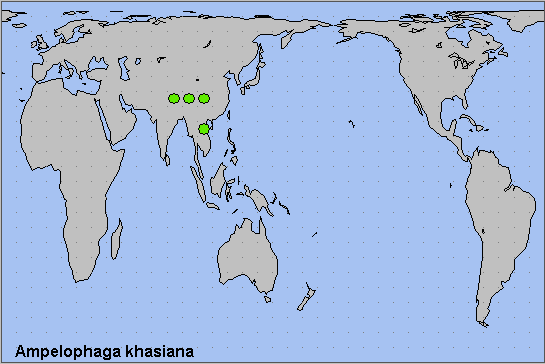
 Return to Sphingidae of the Eastern Palaearctic species list
Return to Sphingidae of the Eastern Palaearctic species list